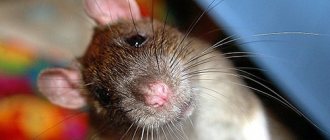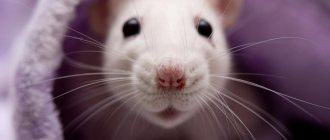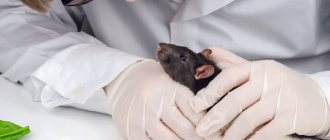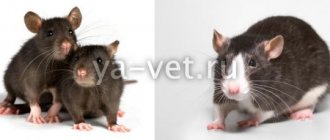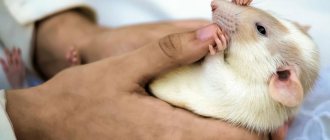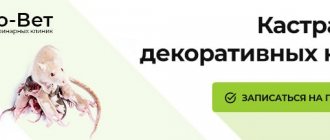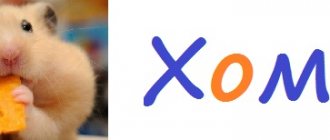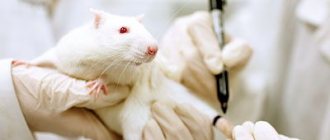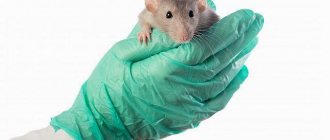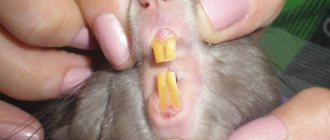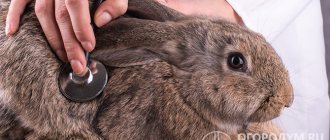Strokes are more common in older rats, but can also occur in young ones. A stroke can be caused by a cerebral hemorrhage, a blood clot in a cerebral artery, a brain abscess, or a tumor. The most common sign of a stroke is weakness or paralysis, which can affect the whole body or just part of it.
During a massive stroke, loss of consciousness, seizures, and irregular breathing may occur. Rats can also have a series of small strokes that cause symptoms to worsen. Bleeding from a pituitary tumor can cause symptoms similar to a stroke.
Is a stroke in a rat a death sentence?
Fortunately, medicine does not stand still, and there are many methods of not only treating stroke in rats, but also preventing it. Therefore, today we can say with confidence that the stroke that occurred in a rat is not a death sentence at all. Timely treatment and subsequent preventive actions can prolong the normal life of a rat after a stroke.
If you want your pet to live a full life, it is very important to treat your rodent after a stroke only under the supervision of a veterinarian. Timely detection of a stroke and timely prescribed medications, along with subsequent care, will help cope and return the rodent to normal life.
Important! If you find signs in your rat that indicate a stroke, you should not panic and remember the main points - what to do if your rat has a stroke:
- put the animal on its side;
- check your mouth - free it from vomit/saliva, check if your tongue is stuck;
- go to the veterinary clinic.
You can't do:
- apply cold to the rat's head - cold can provoke spasm of the affected vessels, causing even more harm;
- give medications without instructions from a veterinarian;
- do not give any injections.
When transporting, it is very important not to disturb the animal; it should be in a lying position, there is no need to turn it over or try to revive it.
Definition of stroke - what is it?
To understand how to overcome a disease, you need to know what it is, the reasons for its occurrence and ways to help if you suddenly notice symptoms of a stroke in a rat.
Stroke is an acute disturbance of normal cerebral circulation (CVA), in which typical symptoms appear in a short period of time and persist throughout the day. This disease leads to many neurological disorders and even death.
Stroke Prevention
Future strokes can be prevented by following your veterinarian's advice and prescribing medications according to a treatment plan developed by an animal expert.
A low-fat, low-calorie diet may also help prevent stroke, especially if your rat is overweight. Regular activity best supports cardiovascular health.
Types of stroke
Stroke in pet rats is divided into two types - hemorrhagic and ischemic.
Hemorrhagic stroke is intracerebral hemorrhage. Ischemic stroke is a disorder of cerebral blood circulation that damages brain tissue.
For convenience, consider the table:
| Hemorrhagic | Ischemic | |
| Onset of the disease | Sudden | Gradual |
| External signs | Increased sweating, cramps, hyperemia | Not expressed |
| Motor excitement | Expressed | Not expressed/Rarely |
| Convulsions | Yes | Rarely |
| Breath | Snore | Often no change |
| Impaired consciousness | Swift | Slow |
Based on the above, we can conclude that with a hemorrhagic stroke in an animal due to a rupture of an artery or a traumatic brain injury, the stroke occurs spontaneously, and this type of disease is considered more dangerous, more often leading to death.
Ischemic stroke, which occurs as a result of narrowing or blockage of individual vessels, occurs differently; if the development of this type was rapid and with loss of consciousness, then, most likely, an embolic type occurred.
Brain contusion (concussion) - symptoms and treatment
A patient with suspected traumatic brain injury should receive medical attention as soon as possible. Since it is impossible to reverse brain damage resulting from trauma, treatment measures should be aimed at stabilizing the patient's condition and preventing secondary damage.
Conservative treatment of brain contusions
In the setting of traumatic illness, decreased or increased intracranial pressure, decreased blood oxygen saturation, high temperature, and increased blood glucose levels can have a detrimental effect on the brain. In this regard, the main directions of therapy for people with severe bruises are identified [4]:
- breathing support (ventilators, oxygen mask);
- correction of blood circulation and infusion therapy (medication);
- treatment of intracranial hypertension;
- neuroprotection - protection of neurons from damage, carried out with medications.
Basic therapy. For victims with severe TBI, an open airway is created by removing saliva, blood and vomit. Sedatives and muscle relaxants are used as needed (designed to relax muscles, block nerve impulses and reduce pain.). Correction of elevated body temperature is necessary (using antipyretic drugs and/or physical conditioning methods) [4].
The development of convulsive syndrome in persons with a brain contusion is considered dangerous and requires immediate response. Seizures are always accompanied by rapid intracranial hypertension, an increase in the volume of intracranial hematomas, increased oxygen consumption in the brain, its blood supply and increased cerebral edema [13]. Prophylactic use of anticonvulsants (according to multicenter studies) in people with TBI reduces the likelihood of seizures in the acute period, but does not reduce the risk of their occurrence in the long-term period.
All persons with a cerebral contusion require prevention of thromboembolic complications (deep vein rhombosis of the lower extremities and pulmonary embolism), which involves the use of compression stockings, increased physical activity and anticoagulant therapy whenever possible. Mortality in thrombosis of the veins of the lower extremities reaches 9-50% [7].
It is also necessary to control blood glucose levels and prevent complications from the gastrointestinal tract (stress ulcers, gastrointestinal bleeding). The main reason for the development of stress ulcers is the release of catecholamine hormones during injury, which are produced in response to stress, insufficient blood supply to the upper gastrointestinal tract and disruption of its self-regulation.
Respiratory support. Indications for respiratory support [3][10]:
- depression of the level of wakefulness to stupor or coma;
- lack of own breathing;
- acutely developed breathing rhythm disturbances, pathological type of breathing (Cheyne-Stokes, Kussmaul);
- tachypnea (rapid shallow breathing) more than 30 respiratory movements per minute;
- clinical signs of hypoxemia (lack of oxygen in the blood) and/or hypercapnia (excess carbon dioxide): partial pressure of oxygen in arterial blood (PaO2) less than 60 mm Hg. Art.; hemoglobin saturation with arterial blood oxygen (SaO2) is less than 90%; partial pressure of carbon dioxide in arterial blood (PaCO2) more than 55 mm Hg. Art.;
- status epilepticus (epileptic seizures do not stop for more than 30 minutes);
- maxillofacial trauma combined with trauma to the facial skeleton, cranio-orbital region (near the orbit and adjacent areas) and/or chest.
The main task of respiratory support is to maintain normal carbon dioxide tension (PaCO2 - 30-35 mm Hg) and the necessary oxygenation of blood in the arterial bed (PaO2 more than 100 mm Hg) [6][7].
If the duration of mechanical ventilation is more than 48 hours after the start of breathing support, a tracheostomy should be performed (an operation to create an external opening in the wall of the trachea to establish breathing). When a brain contusion is combined with trauma to the facial skeleton and chest, it is preferable to perform a tracheostomy immediately upon admission of the victim to the hospital [10].
Correction of blood circulation and infusion therapy. More than half of patients with a decrease in wakefulness to stupor and coma are in a state of dehydration upon admission to the hospital. Causes include bleeding, insufficient fluid intake, overheating, vomiting and/or diabetes insipidus. Performing adequate infusion therapy (intravenous administration of medicinal solutions and drugs using a dropper) makes it possible to achieve a normal total blood volume, normalize cardiac output and the delivery of blood and oxygen to the brain.
The injured brain is extremely sensitive to low blood pressure (below 90 mm Hg), which a healthy brain tolerates normally. Therefore, the management of patients with severe TBI involves maintaining blood pressure (BP should be at least 90 mm Hg), which is necessary for adequate brain perfusion (providing it with oxygen and glucose) in conditions of edema [4][5][6] [7][9]. However, aggressive attempts to maintain blood pressure using vasopressors (vasoconstrictors) should be avoided due to the risk of respiratory distress syndrome (pulmonary edema with difficulty breathing) and cerebral edema [4][7].
Treatment of intracranial hypertension. To select adequate treatment tactics, it is necessary to distinguish between intracranial and extracranial causes of high ICP. The former include intracranial hematomas, bruises, edema and/or cerebral ischemia, epileptic seizures, and meningitis. The second is a lack of oxygen supply, inadequate sedation or ventilation, impaired venous outflow from the cranial cavity, increased intrathoracic and intra-abdominal pressure [1][3]. All these reasons can accompany brain contusion.
Sedation and analgesia are first-line interventions for the treatment of intracranial hypertension [4][7]. The head of the bed must be raised by 30-40° to improve venous outflow from the cranial cavity. To treat increased intracranial pressure and protect the brain from secondary damage, craniocerebral hypothermia (lowering brain temperature) is used. It is sufficient to carry out moderate hypothermia (T = 30-31 °C) [1][4]. The use of hyperbaric oxygenation (saturation of the patient with oxygen under high pressure) is pathogenetically justified in persons with brain contusion, since this method increases the oxygen tension in arterial blood and improves oxygen saturation of the brain.
To reduce intra-abdominal pressure, drugs are used that improve intestinal motility and normalize the function of the gastrointestinal tract [4][6]. If intracranial hypertension is not responsive to drug therapy, decompressive craniotomy is indicated.
Neuroprotection. Currently, the use of neuroprotective drugs is a promising direction in the treatment of brain contusions [9]. Based on their mechanism of action, neuroprotectors are divided into several types:
- Calcium channel blockers (Nimodipine, Breinal, Dilceren, Nimopin, Nimotop). They reduce the entry of calcium ions into the cell, reduce the level of damage and death of nerve cells under the influence of neurotransmitters and prevent apoptosis (programmed cell death).
- Antioxidants and antihypoxants (Actovegin, polyethylene glycol superoxide dismutase, Solcoseryl, Neurox, Mexidol, Armadin, Cytoflavin, Neurocard, Astrox, Meksifin, tocopherol, Methostabil, ascorbic acid, Ascovit, Nootropil, Piracetam, Noocetam, Melatonin, Cavinton, Vinpocetine, Cohen winter Q10). These drugs are nitrogen synthase antagonists, they prevent the formation of free radicals, restore the activity of antioxidant enzymes, accelerate glycolysis (the process of glucose oxidation), increase resistance to hypoxia and improve cerebral blood flow.
- NMDA receptor antagonists (Memantine, Memantal, Memorel, Noodzheron, Akatinol, Memikar, Mirvedol, Memaneurin). Reduce the damaging effects of glutamate.
- Blockers of the inflammatory and immune response (Cycloferon, COX-2 inhibitors, CD11 and CD18 antibodies). Reduce the severity of the inflammatory reaction.
- Stabilizers of cell membranes: intermediate products of phosphatidylcholine synthesis (Recognan, citicoline, Ceraxon, Proneuro, Quinelle, Neuropol, Neurocholin, Noocil, Ceresil Canon), magnesium and potassium preparations (magnesium sulfate, Aspangin, Pamaton, Asparkam, Panaspar, Panangin).
- Drugs that improve synaptic transmission (precursors for acetylcholine synthesis - Cereton, Cerepro, Gleatser, Holitylin, Delecit, Gliatilin).
- Apoptosis blockers (caspase-3 inhibitors, calpain inhibitors).
- Drugs with a neuron-specific neurotrophic effect (Cortexin, Cerebrolysate, Cerebrolysin).
- Immunosuppressants (cyclosporine A). Suppress the immune response.
Nutrition for severe brain contusion . With serious damage, patients, as a rule, cannot eat on their own, so early nutritional support (i.e., the introduction of nutrients into the body) is necessary. Such support should match the patient's protein and energy needs. Basic energy metabolism in patients with severe brain contusion corresponds to 20-25 kcal/kg per day [4][6].
Surgical treatment of brain contusions
Some patients with severe traumatic brain injury are transported to the operating room after a head CT scan. The purpose of surgery for severe brain contusion is to remove massive intracranial hematomas or correct elevated ICP.
Not all patients with TBI require emergency intervention. Since the size of a brain contusion and the volume of an intracranial hematoma may increase during the first hours/days after injury, dynamic monitoring is recommended. Treatment of such patients is carried out in an intensive care unit. If neurological disorders increase or intracranial pressure increases (if an ICP monitoring sensor was installed), a control CT scan is performed. If a significant increase in the volume of the hematoma or displacement of the brain is diagnosed, the safest option will be surgical intervention to prevent brain death.
Before surgery, the hair over the affected area of the brain is shaved. After cutting the scalp and removing the skin flap, the bone is cut out. The bone is removed and the underlying dura mater is opened with the utmost care. The doctor removes the hematoma or brain contusion. In the presence of severe cerebral edema, plastic surgery of the dura mater is performed using a patch from one’s own tissue or artificial replacement material. This is necessary to prevent further displacement of the brain. In such cases, the bone is not put back in its original place.
Before “closing” the wound, it is possible to install an ICP sensor if it has not been installed previously. Upon completion of the operation, the patient is transferred to the intensive care unit for intensive treatment measures aimed at combating cerebral edema and preventing infectious and thromboembolic complications.
Decompressive craniotomy is the most aggressive treatment for intracranial hypertension [3][9]. It is used when conservative therapy is ineffective. The main goal of decompressive trephination is to increase intracranial volume. As a result, the pressure in the cranial cavity is reduced and the blood supply to the brain is normalized.
Decompressive trepanation includes infratemporal and bifrontal decompression, temporal lobectomy and hemicraniectomy. They are carried out in cases of pronounced displacement of brain structures and persistent intracranial hypertension in patients with clinical and CT signs of brain compression.
Possible postoperative complications. In the long-term postoperative period of TBI, epilepsy is registered in 13% of patients, and post-traumatic hydrocephalus in 11% [3]. Post-traumatic epilepsy occurs due to the formation of a pathological focus in the brain. Post-traumatic hydrocephalus is caused by impaired circulation (formation of adhesions) and absorption of cerebrospinal fluid.
Causes of stroke. Etiology of the disease
This disease has many causes, including internal and external factors:
- Internal – genetic predisposition, changes associated with the age of the animal, heart/vascular/kidney diseases, brain tumors, thrombosis, embolism.
- External – poor diet, inactive lifestyle, unfavorable living environment, excess weight.
In addition to the main causes, for each type of stroke, separate factors are identified that can trigger the development of the disease.
| Ischemic | Hemorrhagic |
| Hypertension | Poisoning with rat poison |
| Endocrine diseases | Head injuries resulting in brain injuries |
| Kidney/heart/vascular diseases | Autoimmune diseases |
Unfortunately, it is not always possible to perform a CT scan or ultrasound on an animal to determine the exact cause of a stroke; in this case, a diagnosis is made - idiopathic stroke, i.e. It occurs suddenly, without reason, but such an illness always has a trigger factor and for subsequent recovery it is advisable to identify it.
Without stopping the provoking factor, there is a possibility of repeated strokes and subsequent death of the pet.
Stroke in a rat: symptoms and treatment
A stroke in its symptoms may be similar to other diseases or neurological disorders, so in this case it is impossible to do without consulting a doctor; also, along with characteristic manifestations, there may be nonspecific signs of a stroke in a rat, which also complicates the diagnosis.
Treatment involves complex therapy aimed at relieving symptoms and regenerating brain cells.
What to do if you have a stroke, treatment
After making the correct diagnosis, the veterinarian will select the appropriate treatment for the rat. Typically, clinical recommendations for stroke are aimed at restoring brain function and eliminating associated painful symptoms. An approximate treatment regimen for a decorative rat after a cerebrovascular accident is as follows:
- Intravenous administration of rehydration solutions to eliminate dehydration. Usually, for a stroke, Regidron or Gidrovit is prescribed. Such solutions not only compensate for the lack of fluid, but also replenish the deficiency of salts and minerals.
- Administration of corticosteroids to reduce cerebral edema, reduce intracranial pressure, and eliminate inflammation. Prednisolone or Dexamethasone helps rodents most effectively.
- Taking diuretics to eliminate and prevent swelling. Lasix is considered the best drug for rodents. The medicine not only relieves swelling, but also normalizes blood pressure and relieves stress on the heart.
- Inhalation of oxygen to activate the activity of brain cells. Ozone therapy has a similar effect - intravenous administration of ozone, from which oxygen is synthesized.
- Antiemetics if a small patient has nausea and frequent vomiting - Onitsit, Cerucal, Tropindol.
- Injections of vitamins (A, B, C, D, E, P) - help restore motor and cognitive functions, increase brain activity.
- Sedatives to calm and restore the psycho-emotional state of the pet. Rats are usually prescribed special veterinary medications, such as Fospasim or Fitex. But human medicines are also quite suitable - Persen, Novopassit, Tenoten.
In the list of prescribed medications, the doctor will indicate the dosage, which must be strictly followed. Even a slight deviation from the dose can be fatal for a tiny animal.
Symptoms of a stroke in a rat
How severe the symptoms of a stroke will be depends on the degree of damage to brain cells. Typically, signs of a stroke in a rat appear in a fairly short period of time.
Stroke in its symptoms may be similar to other diseases or neurological disorders, so in this case it is impossible to do without consulting a doctor; also, along with characteristic manifestations, there may be nonspecific symptoms, which also complicates the diagnosis. If you notice signs of a stroke in rats, it is very important to remember not only them, but the order, severity and duration with which they appear, this is very important for establishing an accurate diagnosis and subsequent treatment.
Just like with people, the sooner help is provided, the greater the chance of recovery. It is important to remember that when stroke occurs in rats, symptoms affect treatment.
For convenience, consider a table of the main characteristic symptoms of a stroke in a rat:
| Symptoms | Frequency |
| Falls over on its side | Almost always |
| Hard breath | Always |
| Loss of coordination | Always |
| Visual impairment | Almost always |
| Emotional instability | Almost always |
| Convulsions | Rarely |
In addition to the main symptoms, there may be other atypical signs, but if you notice several of the above signs of a stroke, you should immediately seek help from a veterinary clinic.
What to do if your rat has a stroke
If you think your rat has suffered a stroke, take him to a veterinary hospital as soon as possible. This is important to make a correct diagnosis and ensure that your pet can receive the treatment it needs.
Diagnosis helps rule out other health problems, especially since stroke symptoms can mimic many other diseases.
An MRI is almost always required because the images clearly show clots and bleeding in the brain.
Strokes are often accompanied by other diseases and disorders. In fact, research shows a number of medical conditions that may be present during a stroke.
A few examples include diabetes, hypothyroidism, and blood parasites.
Your veterinarian will test the urine and blood to determine if these or other conditions are the underlying cause of your rat's stroke.
High blood pressure and plaque buildup in the blood vessels can also be contributing factors, as can injury, blood vessel damage, and blood abnormalities. In particular, blood disorders related to clotting factors may be a problem.
Expect an ECG, as well as tests that measure blood clotting time and ability.
Clinical signs and diagnosis of stroke in rats
The following symptoms may be noticed:
- Apathy - the animal shows no interest in eating or playing.
- Emotional instability/changes in behavior - the animal may show aggression or frightenedly rush around the cage, thus showing signs of anxiety.
- A characteristic sign of a stroke is redness of the white of the eye or complete blindness - which can also be noticed by the strange behavior of the animal.
- Loss of coordination: the rat will not be able to walk straight, it will fall over on its side, and all its movements become clumsy.
- Tilt of the head to one side - the muscles lose their tone, muscle weakness may persist for several weeks after the attack.
- Spontaneous bowel movements - due to weakness of the abdominal muscles, which can also be affected by a stroke.
- Breathing disorders - breathing becomes shallow and shallow, it is clear that the animal is having difficulty breathing.
- Muscle spasms.
- Paralysis - complete or partial.
It is important to remember that in addition to typical symptoms, there may be signs that are not characteristic of a stroke.
How to understand that a rat is having a stroke: symptoms and diagnosis
There are several characteristic symptoms by which the owner of a rodent can understand that the rat has a cerebrovascular accident:
- depressed state;
- unreasonable aggression, increased anxiety;
- problems with orientation in space, unsteadiness of gait;
- hemorrhage in the eyeballs;
- deterioration or loss of vision (usually in one eye);
- increased release of porphyrin;
- difficulty breathing, shortness of breath;
- drowsiness, or, on the contrary, overexcitation;
- dehydration (when pulled, the skin is poorly restored, dry mucous membranes);
- vomiting, diarrhea;
- involuntary muscle contraction, twitching;
- weakness in the limbs, complete or partial paralysis on one side of the body is possible;
- decreased appetite.
Some of the symptoms listed are characteristic of many other diseases. Therefore, for diagnosis, you will need to show the rat to a veterinarian. The specialist will examine the animal and prescribe an ultrasound and CT scan of the brain, radiography, and ophthalmoscopy. Unfortunately, not all veterinary clinics are equipped with the appropriate equipment.
In such situations, the doctor makes a diagnosis based on the animal's behavioral reactions. For example, he puts the pet’s paw in an uncomfortable position and observes whether the animal will return it back, and if so, how quickly and confidently the rodent will be able to do this. Or gradually moves the ballpoint pen to the side, behind the pet’s ear. If the rat does not turn its head, it indicates the presence of problems with vision, motor activity, and reaction to events occurring around it.
Treatment methods
The main goal of drug treatment for stroke in rats is to negate the negative consequences after the stroke has occurred and remove inflammation from the cells. Along with therapy, it is very important that the animal feels comfortable and is surrounded by care and proper care.
There is no single cure for the consequences of a stroke; it is a whole range of measures, including:
- Rehydration of the body - for this, a rehydration solution is administered.
- Anti-inflammatory drugs - to relieve inflammation in brain cells and tissues.
- Antiemetics - if after first aid it does not go away and the animal continues to vomit.
- Sedatives - help cope with disorientation.
- Antibiotics - to prevent the addition of a secondary infection, because The rodent's body is weakened after a stroke.
- Oxygen - to eliminate the effects of brain hypoxia.
- Corticosteroids provide comprehensive treatment to eliminate the severe consequences of a stroke.
- Diuretics - to prevent swelling.
Before starting treatment, the specialist must carry out a number of diagnostic measures that are aimed at establishing a diagnosis and the reasons that led to the disease.
For diagnostic purposes, a CT scan (computed tomography of the head) and an X-ray of the rat’s head can be used; these measures will help identify hematomas and/or tumors. An ophthalmoscopy examination will help identify disorders in the retina and signs of hypertension; these data are necessary for prescribing therapy.
After diagnosis and treatment, the animal is sent home; further care and rehabilitation depends on the owner of the animal.
The attending veterinarian decides how to treat a stroke in a rat; without the necessary knowledge, self-medication can harm the animal even more, which will lead to dire consequences.
First aid for a stroke: what to do before the doctor arrives
October 29 is World Stroke Day. For this reason, together with the doctor, we have compiled a detailed guide to first aid for a stroke and found out what should not be done under any circumstances
What is a stroke and why is it dangerous?
A stroke is a disorder of blood circulation in the brain. It can occur due to a ruptured vessel or blockage by a blood clot. In this case, the nerve cells do not receive the required amount of oxygen, glucose and other nutrients, which can lead to their death.
There are several factors that increase the risk of stroke, including: excess weight, high cholesterol, diabetes, hypertension, alcohol and drug use, and smoking. In addition, doctors take into account genetic predisposition and age: the disease most often affects those over 45 years old.
Stroke can be ischemic or hemorrhagic. Subarachnoid hemorrhage is also isolated, which is rare, but in 50% of cases is accompanied by death. He is characterized by acute pain in the back of the head, convulsions, vomiting and loss of consciousness are possible.
Ischemic stroke, or cerebral infarction, is the most common type of cerebrovascular accident. The immediate cause of ischemic stroke is blockage of a vessel supplying the brain. This may occur due to the formation of a blood clot or its entry into the lumen of the vessel. People with atherosclerosis, cardiac arrhythmias, or heart valve disease have an increased risk of developing blood clots. Ischemic stroke can occur when you take medications on your own without a doctor's prescription (for example, diuretics or combined oral contraceptives).
Symptoms of an ischemic stroke develop over a short period of time and are not accompanied by headaches, since there are no pain receptors in the brain. Most often this happens at night when a person is sleeping, and in the morning when waking up he discovers that an arm or leg is not working or speech is impaired.
In a hemorrhagic stroke, the wall of a vessel ruptures and blood permeates the brain tissue. Frequent causes of hemorrhagic stroke are increased blood pressure, taking drugs that reduce blood clotting, disruption of the structure of the vessel wall (aneurysm) or congenital anomalies of the vascular bed - arteriovenous malformations. Hemorrhagic stroke develops quickly and is often accompanied by headache. If blood soaks into the choroid of the brain, where there are pain receptors, a person may lose consciousness. This subtype of stroke has a high rate of death, but if the person survives, he recovers well.
First aid for stroke
It is advisable that a person with a stroke be taken to hospital as soon as possible - within three hours of the onset of the first symptoms. Therefore, it is important to properly organize assistance for a person with suspected stroke.
Call an ambulance. If you experience symptoms of a stroke, ask for help and have someone else call the doctor. Provide brief information about the patient (age, what happened). Leave your contact information so we can contact you. Be prepared to meet the physician and provide access to the patient.
Help the patient find a safe position: it is best to lie on his side with his head slightly elevated.
While you are waiting for an ambulance, try to find out from the patient when the symptoms began, what chronic diseases does he suffer from and what medications does he take? This information will save doctors time and allow them to quickly make decisions.
If a person is unconscious and not breathing, cardiopulmonary resuscitation must be performed. However, in order to provide it correctly, it is necessary to undergo specialized training courses.
If the patient has difficulty breathing, remove restrictive clothing (tight collar, tie or scarf) and open the windows.
— If a person is cold, cover him with a warm blanket.
— While the ambulance is traveling, do not under any circumstances try to give the patient something to drink, feed, or force him to stand up. The person may have difficulty swallowing and may choke. And when trying to stand up due to high blood pressure or lack of coordination, there is a high risk of falling and receiving additional injuries.
- Monitor the person closely for any changes in their condition. Be prepared to tell the emergency operator or doctor about their symptoms and when they started. Be sure to indicate whether the person fell or hit their head.
— In some cases, it is advisable to transport the patient to the nearest hospital yourself if you are not confident in the efficiency of the team.
— Discuss this decision with the emergency operator.
It is good if several people provide assistance. For example, one will be responsible for resuscitation, the second will monitor pulse and blood pressure, and the third will talk on the phone with doctors. Call neighbors and others for help if the sick person is on the street or in a public institution.
Signs and symptoms of stroke
Depending on the severity of the stroke, symptoms may be mild or severe. You need to know what to look for. To check for warning signs of a stroke, you can use the Western mnemonic FAST, which means [4]:
F - face - “face”
A - arm - “hand”
S - speech - “speech”
T - time - “time”
The first symptom is facial asymmetry. If you ask a person to smile, he will not be able to do it; one corner of his mouth will remain downturned. When the patient sticks out his tongue, it may deviate to one side. As soon as you have performed a small operational test, you must immediately call an ambulance. Often the victim does not respond to requests, cannot speak coherently and cannot raise both hands at the same time; sometimes he is in a state of disorientation, the pupils are dilated or there is no reaction to light.
Transient ischemic attack can be difficult to identify based on symptoms alone [5]. They resolve completely within 24 hours and often last less than five minutes. The attack causes temporary circulatory failure and may be followed by a more severe stroke, so it is important to see a doctor as soon as possible.
However, it is worth remembering that only a small part of the brain is responsible for movement and sensitivity, therefore, if blood circulation is disrupted in other parts of the brain, a variety of symptoms may occur: impaired speech, swallowing, vision, dizziness, lack of coordination, confusion and loss of consciousness, epileptic seizures, sudden memory loss or inappropriate behavior of the patient and others. The main task is to call a doctor if someone feels unwell: unusual symptoms appear that were not there before. It’s better to be on the safe side than to miss time, which is the most important factor determining the prognosis for a stroke.
First aid for a stroke before the ambulance arrives
At home, you can carry out a set of measures to support the patient, but in any case you cannot do without professional doctors. If blood pressure rises, it does not need to be lowered; this is an adaptive reaction of the body. Thus, the body tries to improve blood supply to the brain through special “backup pathways” of blood circulation - collaterals. You should not give the patient any medications because you do not know whether the patient has a stroke or other illness. In addition, ischemic and hemorrhagic strokes are treated completely differently. It is the doctors’ task to make a diagnosis within 3 hours, deliver to a specialized center for the treatment of stroke and prescribe appropriate treatment. It is important to understand that nerve cells die within 5 minutes if they do not receive sufficient blood supply. Therefore, the infarction zone can no longer be saved, but around the zone of cell death a border region is formed (the so-called “penumbra” - penumbra), where nerve cells are on the verge of death. If left untreated, the penumbra area increases and more and more cells die, which is manifested by worsening stroke symptoms and a poor prognosis for life and subsequent recovery.
Self-help for stroke
If the symptoms are minor and the victim remains conscious and able to move, he can administer first aid to himself. But only after an ambulance is called. In case of a stroke it is worth:
- Tell someone other than doctors that you feel unwell. Call neighbors and relatives who are nearby.
— Take a horizontal position with your head raised or in a position lying on your side.
- Free your neck and chest from constricting jewelry, shirt collar, tie and other clothing.
- Do not get up until the ambulance arrives.
What will doctors do?
Diagnosis and treatment of the patient is carried out in the neurology department. If a little time has passed since the onset of the attack, the patient has a chance to fully recover.
At the hospital, he undergoes a CT scan and thrombolytic therapy: a drug that dissolves blood clots is injected. In some cases, doctors choose thromboextraction - mechanical removal of blood clots from blood vessels.
Recovery after a stroke
Until the person’s condition stabilizes, he or she must remain in an intensive care unit (resuscitation unit). After his condition improves, he is transferred to a regular ward and prescribed medications to prevent a recurrent stroke. In addition to doctors, rehabilitation therapists, speech therapists, and clinical psychologists work with the patient. The first days and weeks are very important for subsequent recovery. The rehabilitation process depends on many factors, including the speed of first aid and treatment provided, and the presence of chronic diseases.
The first stage of recovery takes place in the hospital: the patient's condition is assessed and stabilized. After treatment, a person can remain in the hospital or be discharged home, but in any case, the doctor’s recommendations must be strictly followed. If stroke symptoms are mild, rehabilitation can be done on an outpatient basis. First of all, it is important to relieve muscle tension, strengthen the mobility of the limbs, and stimulate their mobility with simple physiotherapeutic exercises [6].
If you are caring for someone who has had a stroke, write down your doctor's instructions for further treatment [7]. The patient may need systematic transportation to a rehabilitation specialist or organization of medical care at home.
Stroke Prevention
To reduce the risk of stroke, you need to follow the basic rules of a healthy lifestyle: eat a varied and high-quality diet, exercise, spend time outdoors, relax, and eliminate bad habits. Patients over 40 years of age should undergo periodic medical examinations (dispensary examinations or check-up programs). It is important to carry out timely treatment of chronic diseases that can increase the risk of stroke.
Doctor's comment
Sergey Makarov, neurologist, otoneurologist at GMS Clinic, assistant at the department of nervous diseases at the Institute of Professional Education of the First Moscow State Medical University named after. THEM. Sechenov
– What drugs can be used safely?
– Strange as it may sound, no medications should be given to a patient suspected of having a stroke. Even medications to lower blood pressure can worsen the prognosis, since increased blood pressure is the body’s protective reaction to blockage of the vessel. Unfortunately, there are currently no drugs with proven effectiveness that can clinically significantly change the course of stroke. You need to call a doctor, and then specialists will decide what medications are needed and in what doses.
– How does the lack of first aid affect further treatment?
– The main principle of medical ethics is primum non nocere. “First of all, do no harm.” Therefore, the main help is to ensure the safety of the patient while he waits for emergency medical help. This is what this article is about. Currently, many specialized vascular centers have been created in Russia for the treatment of heart attacks and strokes. If the patient is delivered within this time frame during the “therapeutic window” - the time when the blood clot can be dissolved or removed - then the person has a good chance of recovery, although this process is individual. However, often the duration of the stroke cannot be determined or the patient has contraindications to thrombolytic therapy. In such cases, doctors are forced to limit themselves to symptomatic therapy. The patient is ensured that vital functions are maintained and medications are prescribed to prevent a recurrent stroke.
– If you take a patient to the hospital yourself, do you need to call in advance what to take with you, how justified is this, or is it better to wait for an ambulance?
– This issue should be discussed with the emergency operator. In the vast majority of cases, transportation of patients is carried out by an ambulance team. In large cities, emergency services work very quickly. When transporting a patient by ambulance, the patient is already waiting at the hospital, so many patients receive effective treatment for acute cerebrovascular accident. When transporting a patient to the hospital, you do not need to take anything with you, since the patient will go straight to the intensive care unit, where you cannot take personal items.
Link to publication: RBC
How many rats survive after a stroke?
If we recall history, we will notice that rats are quite tenacious creatures; in the wild, these rodents are accustomed to great physical exertion, they have learned to avoid danger, even not to eat food that causes doubts in it or from which its relatives died. Considering this, as well as statistics, 95% of rats not only survive a stroke, but also fully recover! The most important thing is timely provision of assistance. With an accurate diagnosis, correctly prescribed treatment and proper follow-up care, the animal has a favorable prognosis and a high chance of returning to its previous life.
Caring for a Sick Rat
After a stroke in rats, subsequent treatment at home is important, which requires:
- Provide access to food and water.
- Secure your home - remove all gaming accessories for the recovery period;
- Monitor the water balance - check at the drinking bowl whether the rat has been drinking; if not, find out the reasons and eliminate it, for example, help it quench its thirst.
- Massage - the veterinarian will show you how to do it to prevent muscle atrophy.
- Maintain cleanliness and the necessary, comfortable temperature in the rodent’s home.
Regarding the diet during a stroke: no specific diet is required, and if the rat is able to feed itself, its nutrition remains the same, if the animal cannot feed on its own, the owner’s help will be required, then food is supplied through a syringe.
In order to prevent bedsores and ulcers, it is necessary to turn the animal over at regular intervals and change the bedding as it becomes moist, since, most likely, the animal will defecate on itself. During the recovery period, the animal must be under constant supervision and surrounded by care.
If the first necessary assistance is provided on time, then improvements will be noticeable already on the third day; if there is no positive dynamics, then the prognosis of the disease is unfavorable. Along with the treatment provided, it is important how the rat’s body will react to it, and whether it will have a response. If treatment for stroke in rats is carried out correctly and the animal reacts positively to it, then the next day improvements will be noticeable, and after a couple of weeks the animal will fully get back on its feet.
If a rat begins to itch after a stroke , you should seek a second consultation with your doctor; itching may indicate:
- neurological disorders;
- improper care, and subsequently skin pathologies arose;
- allergies to medications.
After the examination, the doctor will determine the cause of the itching and suggest treatment options. The main rule in caring for a sick animal is peace, comfort and care.
Diagnosis of strokes
First of all, it is necessary to conduct a detailed neurological examination. Instrumental diagnostic studies and laboratory tests are also prescribed. In case of a stroke, in the first hours, an MRI or CT scan of the brain is performed, if necessary, CT or MR angiography, color Doppler mapping of blood flow, ECG or Holter monitoring, echocardiography as indicated, monitoring of blood pressure, saturation, assessment of the risk of developing bedsores, assessment of swallowing function [ 1, 3, 6].
Tests for stroke
- Complete clinical blood test, including erythrocyte sedimentation rate (ESR).
- Biochemical blood test with determination of C-reactive protein and homocysteine, glucose level, platelet count, activated partial thromboplastin time, INR.
- Interleukin 10.
- Extended coagulogram.
- Determination of acid-base status.
- General urine analysis.
To prepare for neurosurgical intervention, a blood test is additionally performed for hepatitis, syphilis, HIV, blood group and Rh factor determination.
Stroke in a rat: disease prevention
Stroke prevention is important not only for a healthy animal, as a preventive measure, but also for those who have already suffered a stroke, in order to prevent repeated attacks.
According to veterinarians, nutrition is not an unimportant part; to prevent this serious disease, it is necessary to include in the rodent’s diet foods rich in Omega-3 acids and other antioxidants; these components are the prevention of many cardiovascular diseases, including stroke.
In addition to nutrition, it is necessary to contact the clinic at the first signs of any disease. This will prevent the development of serious illnesses that can subsequently cause a stroke.
It is easier to treat any illness at the initial stage than to deal with the negative consequences in an advanced case.
Experts have identified a number of preventive tips that, if followed, can prevent the development of a stroke:
- balancing nutrition;
- monitor weight - prevent your pet from becoming overweight
- treatment of diseases in a timely manner - responsibility for the life and health of the pet lies with the owner;
- active lifestyle - having gaming accessories will help avoid physical inactivity;
- eliminating possible stress.
By following these simple tips, you will extend the life of your pet, making it full and happy, and getting a reliable friend in return.
Results and discussion
In the 1st series of experiments, the study of the dynamics of the development of NBS in animals subjected to kindling for 10 days, with a severity of seizures of 1-2 points, showed that both in experimental animals (n = 11) subjected to kindling and in control animals ( n=13) with the introduction of saline, autotomies appeared on the 2nd day after surgery. The number of animals with autotomy was 4 (36.36%) out of 11 in the experimental group, 4 (30.77%) out of 13 in the control group (Fig. 1) , the average severity of autotomy was 3.5 (1; 6) and 2 .5(1; 6) points respectively.
Rice. 1. Dynamics of the development of neuropathic pain syndrome in rats subjected to kindling for 10 days, with a severity of seizures of 1-2 points, assessed by the number of animals with limb autotomy.
Fig. 1. Neuropathic pain syndrome in rats is subject to kindling for 10 days with seizure score 1—2, estimated by the number of animals with limb autotomy.
It should be noted that with the development of autotomy in animals, healing of wounds of the operated limb was also detected: in 2 of 4 experimental animals on the 7th and 23rd days, in 1 of 4 control animals - on 25 th day. In both groups, one animal with a severity of autotomy of 11 points was identified: in the experimental group - on the 5th day after surgery, in the control group - on the 25th day; they are euthanized.
Thus, the development of NBS in animals that were kindled for 10 days and with seizure severity of 1-2 points did not differ from that in control animals for all studied indicators.
A study of the dynamics of the development of NBS in animals (n=12) subjected to kindling for 24 days with a seizure severity of 4-5 points showed that autotomies appeared on the 7th day after surgery in 1 (8.33%) of 12 animals, on the 17th day - in 5 (41.7%) animals, and the average severity of autotomy was 3 and 4 (3; 4) points, respectively. The number of animals with autotomy during the entire observation period was 58.33%, the average severity of autotomy was 3.5 (2; 4) points.
In 1 (8.33%) of 12 control animals (injection of saline solution for 24 days), autotomies appeared on the 3rd day after surgery (Fig. 2) . The severity of autotomy was 3 points (Fig. 3) . On the 5th day of observation, the number of animals with autotomy was 5 (41.67%) out of 12, and the average severity of autotomy was 4 (2; 4) points. The number of animals with autotomy during the entire observation period was 6 (50%) out of 12, the average severity of autotomy was 5 (4; 5).
Rice. 2. Dynamics of development of neuropathic pain syndrome in rats subjected to kindling for 24 days, with a severity of seizures of 4-5 points, assessed by the number of animals with limb autotomy.
* — p=0.05 compared to control animals.
Fig. 2. Neuropathic pain syndrome in rats subject to kindling for 24 days with seizure score 4—5 estimated by the number of animals with limb autotomy.
* — p=0.05 compared to the control animals.
Rice. 3. Dynamics of the development of neuropathic pain syndrome in rats subjected to kindling for 12 days, with a severity of seizures of 1-2 points, assessed by the number of animals with limb autotomy.
Fig. 3. Neuropathic pain syndrome in rats is subject to kindling for 12 days with seizure score 1—2, estimated by the number of animals with limb autotomy.
In both groups, one animal with a severity of autotomy of 11 points was identified: in the experimental group - on the 25th day, in the control group - on the 17th day after surgery; these animals are euthanized.
Thus, in animals that were kindled for 24 days, with a seizure severity of 4-5 points, autotomies appeared 4 days later in one animal. From the 17th to the 33rd day of observation, the number of rats with autotomy was the same among experimental and control animals.
It should be noted that during the study, some animals showed bloating and emaciation due to intestinal obstruction. The observed phenomena are most likely associated with chloral hydrate anesthesia, which was used during transection of the sciatic nerve. This assumption is confirmed by literature data on the negative effect of chloral hydrate on intestinal motility and the undesirability of its use in experiments with long-term postoperative observation [15]. To confirm the obtained results, an additional study was repeated in which NBS was reproduced by cutting the animal's left sciatic nerve under ether anesthesia.
In the 2nd series of experiments, the study of the dynamics of the development of NBS in animals subjected to kindling for 12 days, with a severity of seizures of 1-2 points (n = 10), showed that autotomies were detected the next day after surgery in 1 (10% ) animal. The number of animals with autotomy was 5 (50%) out of 10, and the average severity of autotomy was 1.5 (1; 3) points.
On the 2nd day after the operation, autotomy was detected in 1 (9.09%) of 11 animals in the control group, the total number of animals with autotomy during the entire observation period was 3 (27.27%) out of 11, and the average severity of autotomy was 3 (1; 4) points (see Fig. 3) .
Thus, the development of NBS in animals subjected to kindling for 12 days, with a seizure severity of 1-2 points, did not differ from that in control animals for all studied indicators.
A study of the dynamics of the development of NBS in animals that underwent kindling for 27 days, with a severity of seizures of 4-5 points (n = 9) showed that in experimental animals autotomies appeared on the 13th day after surgery in 2 (22.22% ) out of 9 animals, on the 15th day - in 4 (44.44%) animals, and the average severity of autotomy was 4 (4; 4) and 3 (1.5; 4) points, respectively (Fig. 4) . The number of animals with autotomy during the entire observation period was 5 (55.56%) out of 9, and the average severity of autotomy was 3 (2; 3) points.
Rice. 4. Dynamics of development of neuropathic pain syndrome in rats subjected to kindling for 27 days, with a severity of seizures of 4-5 points, assessed by the number of animals with limb autotomy.
* — p=0.05 compared to control animals.
Fig. 4. Neuropathic pain syndrome in rats is subject to kindling for 27 days with seizure score 4—5, estimated by the number of animals with limb autotomy.
* — p=0.05 compared to the control animals.
In 3 (33.33%) of 9 control animals with saline injection for 27 days, autotomies appeared on the 2nd day after surgery. The average severity of autotomy was 1 (1; 4) point. On the 3rd day of observation, the number of animals with autotomy was 4 (44.44%) out of 9, and the average severity of autotomy was 2.5 (1.5; 4) points. The number of animals with autotomy during the entire observation period was 4 (44.44%) out of 9, the average severity of autotomy was 4 (2.5; 4) points.
Thus, in two animals that were kindled for 27 days, with seizure severity of 4-5 points, autotomies appeared 11 days later. From the 15th day of observation, the number of animals with autotomy, as well as the severity of autotomy, did not differ from those in control animals.
Subsequently, in experimental animals with a seizure severity of 4-5 points compared to control animals, there was a tendency to increase the number of animals with the development of autotomy (see Fig. 2 and 4) .
The results of the studies indicate that the development of NBS at the early stage of kindling in experimental animals with a seizure severity of 1-2 points did not differ from that in control animals. At the later stages of kindling, animals with a seizure severity of 4-5 points, subjected to kindling for 24 and 27 days, were more resistant to the development of NBS in the first 16 and 12 days, respectively, after surgery compared to control animals.
It should be noted that in our studies, transection of the sciatic nerve led to the development of pain in only 27-57% of animals. Clinical and experimental data also indicate that neuropathic pain does not occur in all cases of damage to the structures of the somatosensory analyzer and, therefore, for the development of NPS, in addition to damage to the nervous system, a number of additional conditions are required, leading to dysfunction of the systems that regulate pain sensitivity [16]. As is known, the development of neuropathic pain is accompanied by a complex of structural changes at different levels of the nociceptive system. Under these conditions, stable depolarization of neurons and a deficiency of opioid and GABAergic inhibition occur, as a result of which interneuronal interactions are disrupted, neurons are disinhibited, and long-term self-sustaining activity in the form of central sensitization is formed.
Despite the widespread use of the PTZ kindling model, there is still no complete description of the sequence of pathophysiological changes in this process. Increased convulsive activity of the brain during kindling is accompanied by disruption of the functioning of many systems, including GABAergic; The process involves various parts of the GABAA-Cl–ionophore receptor complex (GABAA-RK), which plays an important role in the activity of the antiepileptic system [17], preventing and suppressing epileptic activity.
The convulsant effect of PTZ is associated mainly with the inhibition of Cl– conductivity by GABAA-RK, i.e. with disruption of inhibitory GABAergic mechanisms [18]. An analysis of some features of the dysregulation of the functional activity of GABAA-RK shows that during the kindling process, the functional activity of the GABAergic inhibition system is suppressed in the form of a decrease in both the basal and muscimol-stimulated input of 36Cl– into the synaptoneurosomes of the rat cerebral cortex, i.e. there is a significant weakening of antiepileptic mechanisms [4, 11, 12]. In the process of kindling, there is not only a gradual increase in brain excitability, but also an increase in the activity of inhibitory mechanisms. These include the development of inhibitory postsynaptic potential (IPSP), antagonism of ictal and interictal discharges, as well as short-term inhibitory effects in the form of the inability to develop a convulsive seizure after the next seizure, and long-term (up to 5 days) inhibition [17]. During kindling, in different regions of the brain, both an increase and a decrease in the effectiveness of inhibitory GABAergic processes can occur. It is very important that in the very area of the brain that is subjected to electrical stimulation (ES), for example, during kindling of the hippocampus (ES of Schafer collatarales), there is a decrease in muscimol-stimulated Cl– conductivity in the CA1-3 region and an increase in the dentate gyrus [19].
The corazole kindling model shows the dependence of the effects of activation of the antiepileptic system on the stage of kindling development. Thus, in animals with developed kindling, the ES of the dentate nucleus of the cerebellum caused a reduction in convulsive reactions, while the ES of the nucleus during the first stages of kindling caused an increase in seizures. Apparently, the effects of the antiepileptic system are realized with the participation of various structural and functional levels [20].
Kindling is known to disrupt the metabolism and release of amino acids, which modulate brain excitability and play an important role in the development of seizures. However, the role of different amino acids in specific brain structures during kindling is still unclear. It is likely that methodological differences between kindling and neurotransmitter measurements may lead to conflicting results, even if the same sampling method is used. This should be taken into account when comparing different studies on the effects of seizures on amino acid levels in the brain. Thus, a study using the microdialysis method showed that extracellular concentrations of glutamate, GABA, alanine and taurine are increased in the hippocampus of kindling rats with a seizure severity of 4-5 points [21]. A later study by the same authors, conducted using high-performance liquid chromatography in rats, showed that in animals with seizure severity of 1-2 points at the initial stage of kindling (PTZ, intraperitoneal at a subconvulsive dose of 35 mg per 1 kg of body weight 3 times a week) There was an increase in the levels of both excitatory (glutamate and alanine) and inhibitory (GABA and taurine) amino acids in the entorhinal cortex. Increased concentrations of glutamate and alanine were detected in the piriform cortex. A significant increase in local GABA concentration was found in the prefrontal cortex, while a decrease was observed in the amygdala. In animals at the final stage of kindling and with seizure severity of 4-5 points, there was a decrease in glutamate levels in the prefrontal and entorhinal cortex and an increase in the amygdala, nucleus accumbens and piriform cortex, while the level of GABA increased in the entorhinal cortex. Alanine content is increased in the hippocampus, amygdala, striatum, nucleus accumbens and piriform cortex. Taurine concentrations in animals with seizure severity of 4-5 points are also increased in the amygdala, nucleus accumbens, entorhinal and piriform cortex. The authors speculate that the increased concentration of inhibitory amino acids, particularly in the entorhinal cortex, may represent a feedback mechanism that is activated during kindling to maintain a balance between excitatory and inhibitory processes in the brain. This is probably one of the reasons why kindled animals did not exhibit a state of constant seizure activity; repeated convulsions occurred only after the next dose of convulsant was administered [22].
Studies conducted on mice subjected to PTZ kindling have also shown mixed changes in the levels of the excitatory and inhibitory neurotransmitters glutamate and GABA. PTZ at a dose of 35 mg per 1 kg of body weight was administered intraperitoneally at intervals of 48 ± 2 hours, a total of 17 injections were made. It was found that in kindling animals that received additional injections of PTZ on the 5th, 10th, 15th and 20th day after the end of kindling, the ratio of glutamate/GABA levels significantly decreased in the cortex, hippocampus, cerebellum and brainstem. Moreover, in animals that did not receive additional injections of PTZ for 20 days after the end of kindling, the ratio of glutamate/GABA levels was significantly higher compared to the control group. A decrease in the levels of norepinephrine, dopamine and serotonin was found in the cortex, hippocampus, cerebellum and brainstem of animals subjected to kindling compared to the control group [23]. The authors believe that an increase in glutamate levels during the interictal period, on the one hand, leads to their re-occurrence, and on the other, to glutamate depletion. The latter may be the reason for its reduced level in the hippocampus and cortex of animals after the end of kindling.
The presented data indicate that during kindling, both an increase and decrease in excitatory and inhibitory processes can occur in different regions of the brain. Thus, when the brain is epileptic, a complex mosaic of functional hyperactivation is created that contributes to the activity of the epileptic system.
As is known, an imbalance of excitatory and inhibitory neurotransmitters can be the cause of hyperactivity of the cerebral cortex during the development of hyperalgesia and other pain conditions [24, 25]. Various mechanisms are involved in the development of central sensitization underlying chronic neuropathic pain, in particular, changes in glutamatergic neurotransmission and loss of tonic inhibitory control, namely a deficiency of glycine and GABAergic inhibition [26–30].
In studies on rats, C. Watson (2016) found a significant increase in the levels of excitatory neurotransmitters glutamate and aspartate in the cortical insula of animals with mechanical allodynia and thermal hyper-algesia that developed after ligation of the right sciatic nerve, compared with control sham-operated animals . At the same time, an increase in endogenous levels of glutamate and a decrease in GABA levels or blocking of strychnine-sensitive glycine receptors in the insula of the cortex of animals of the control group led to a significant increase in thermal hyperalgesia and mechanical allodynia [25]. The use of electroacupuncture in rats after ligation of the sciatic nerve led to a decrease in mechanical allodynia and thermal hyperalgesia, which, according to the authors, is associated with an increase in the expression of GABAA receptors in the hippocampus and periaqueductal gray matter, with a decrease in the level of the excitatory neurotransmitter glutamate in the hippocampus and an increase in the level of the inhibitory neurotransmitter GABA in the periaqueductal gray matter [31]. These results and those of other studies [27, 32] suggest that an imbalance between excitatory and inhibitory neurotransmitters is key in the pathogenesis of both pain and epilepsy.
The presented studies show that already at the early stage of kindling in animals with a seizure severity of 1-2 points, a change in the concentration of excitatory and inhibitory neurotransmitters is observed [22]. An increase in the level of both excitatory (glutamate, alanine) and inhibitory amino acids (GABA) was detected, i.e. There is an increase in both excitatory and inhibitory mechanisms, which is not accompanied by the development of a regulatory imbalance, which may be the reason for the lack of differences between control animals and kindling animals with a seizure severity of 1-2 points. In addition, we have previously shown that the level of functional activity of GABAA-RK during this period practically corresponds to control values [4, 12].
During the development of a state of increased convulsive brain activity during kindling, the antiepileptic system is activated. Endogenous physiologically active substances of various natures take part in the implementation of the effects of the antiepileptic system. The epileptic system itself is an automatic activator of the antiepileptic system, as evidenced by the presence of antiepileptic substances in the cerebrospinal fluid of animals that have suffered seizures [33]. Substances with antiepileptic properties are also found in the cerebrospinal fluid of patients with epilepsy during remission. They probably support the tonic activity of inhibitory mechanisms [34]. Classical neurotransmitters (GABA, NA, serotonin, etc.) also play an important role in the implementation of antiepileptic effects [21, 22, 35, 36]. Their concentration in the cerebrospinal fluid increases during ES of antiepileptic structures of the cerebellum [20]. An increase in the activity of the antiepileptic system shifts the balance towards an increase in inhibitory processes, and this, in turn, leads to an increase in the modulating inhibitory effects of the antinociceptive system [37].
